The Ultimate Insulator Experience
by Lee Brewer
Reprinted from "Crown Jewels of the Wire", October 1998, page 14
When I started collecting insulators, if someone had asked me what my
ultimate dream-come-true concerning the hobby would be, I would have said
something like, "I'd like to be in a room surrounded by thousands of
different insulators, and any of the ones that I wanted, I could have."
This probably is typical of what any of us would say. I am still amazed as I sit
here typing these words that I got to live this dream come true at the NIA
National Show in Williamsburg, VA ! Following is the story of how it all came to
pass.
The Beginning
I started insulator collecting in 1971 when my Pastor introduced me to the
hobby by giving me a brown porcelain 'piece of glass from off of the telephone
wires' (much later I identified it as a U-292). He took me into his basement and
told me to look up to where the floor joists above us met the basement walls.
There, sitting on the sill, nestled between the joists, were many wonderfully
colored different shapes of glass. The only ones I vividly remember were his two
favorites: his orange amber Hemi 19 and his white milk Maydwell 20, He was very
proud of the Maydwell 20 and explained that he traded his cobalt blue Shirley
Temple milk pitcher for it. He believed the piece to be worth $50.00 and unlike
the others, displayed it prominently on his office desk. From then on, I thought
nothing could be greater than to own one of each.
As time went on, I collected
what I could from walking the local tracks and always dreamed of finding an
amber Hemi 19 and a white milk Maydwell 20. Since I could not find these locally
in Erie, PA, my goal became to collect each different one I could find. I knew
nothing of how many different types of insulators there were or how big the
hobby was. My Pastor had given me a copy of Crown Jewels of the Wire, but this
publication was from a 'place out west of us' somewhere, and I could find no one
else who collected insulators from my area. So even with no one else to share my
fun (my Pastor had stopped being active in the hobby for the same reasons), I
kept collecting.
I had an opportunity a few years later to travel to Utah. I
could not believe it when I saw a store dedicated to just selling insulators. I
begged my Grandfather to stop. There were some of the most beautiful pieces of
glass I had ever seen. I asked the shop owner about a white milk Maydwell 20. To
my surprise he told me they were not very expensive. He told me he did not have one in stock, but could get me one for
about $5.00. He got my name and address and told me he would mail it to me.
While browsing in the shop, two insulators made a lasting impression on me -- a
cobalt blue insulator, and a royal purple beehive. I never knew insulators were
made in any other color than amber, white milk, clear, aqua, light-ish blue, and
a weird shade of olive-ish green I had found, Since $35.00 was a little far out
of reach for a child back then, I resigned myself to the fact I would have to
wait for a couple of years until I could get a job to pay for a cobalt blue
insulator. The beehive was also something I desired, but could be next in line
after the cobalt blue.
I gave the store owner $5.00 for a clear Mickey Mouse
(the exotic looking thing I had seen in the that old edition of crown jewels)
and left. I heard from him once after that, but never got my Maydwell 20. My
pastor thought there had been some sort of misunderstanding since the shop owner
had told me the white milk was not an expensive insulator. When I tried to call
the shop after a few months, the phone had been disconnected.
When it came time
for college in 1980, I put my hobby on the back burner because I was moving 600
miles away to Bob Jones University in Greenville, South Carolina. I knew I'd
have no time for my favorite hobby, so, sadly, I left my glass at home. It
nagged at me that I still did not have a white milk, but I figured that surely
the hobby had died since in nine years I had found no other collectors, and the
only shop I had ever seen was gone. The insulators patiently waited 6 years for
me to return home.
Upon graduation from college I knew my glass could be of no
value as I still had not met anyone else who collected them. The few pieces I
found at garage sales and antique stores were always 10 cents to a couple of
dollars, so I knew there was not much sense in me avidly continuing the hobby. I
had recently been married and moved to Hagerstown, MD. I did not want to part
with my insulators, but kept thinking of how much space they took up. I remember
twice thinking I should unload them all for a quarter each at a flea market or
antique shop. That way I'd at least get (maybe) $100.00.
Another 11 years passed
as I kept forgetting about my jewels. There were times I did think of the amber
Hemi 19, white milk Maydwell, and even dared to dream of the cobalt blue and
purple beehives. But I knew these were past memories of childhood that would
never come to fruition. I had moved back to the Erie area and upon transporting
the insulators (still wrapped up from 10 years before) once again thought of trying to find someone to buy them. I never got
around to it.
The Recent Past
I first connected to the internet in February of 1998. I know just about any
subject can be found on the web and after a few sessions (many, many hours) of
excitedly researching anything and everything I could think of, I tried to think
of other categories to look up. Suddenly the idea of typing in insulators.com
came to mind (search engine - what's that?). As I saw the message of
"transferring data" on my screen, I sat on the edge of my chair. The
words "Glass Insulator Home Page" blinked to life and my excitement
exploded from within!. Little did I know this moment would be the catalyst that
would change my life forever! I started to read as I scrolled the screen...
"How many people???"
"CD number - what's that??"
"Books
by McWho-gald?"
"Icon ... NIA ... you have to be kidding - whoever
this is, they've got this hobby down to a science now!"
"Crown Jewels
of the Wire still exists?!? - complimentary copy - is this a dream come
true?"
A few days later, after 25 years, an issue of "Crown
Jewels" was in my hands.
Memories and hopes that had long since been buried
under a label of "impossible - forget it" suddenly came to the
forefront of my mind. Could it be possible I could actually get a white milk
Maydwell 20? The possibility stimulated the same excitement I experienced as a
child upon seeing and holding the insulator that was my Pastor's prize
possession.
I hurriedly looked through the advertisements... "Insulators
for sale and trade ... Hmmm, I wonder what a white milk Maydwell 20 goes for...
For sale by Bill Heitkotter ... fourteen dollars ... fourteen dollars! ... sold!
A cobalt Hemi 19 - $250 - Oh, well. Amber Hemi 19 - $65 - well, not too bad -
maybe some day... purple beehive? Not listed (later I would learn CD145 meant
'beehive') ... can't find one ... have to keep checking back."
Two weeks
later I almost shook with excitement as I slowly unwrapped the Maydwell 20 Bill
had sold me. It had been 25 years, and just staring at this jewel flooded my
mind with a flavor of wonderment I had not experienced since childhood.
I once again became an avid collector. Weekends became insulator hunting
days, and I searched on some of the same lines I walked as a child. Sadly, I
found most of the lines were gone, but I also found, in the remote areas, places
where the poles were rotted, fallen over, and loaded with the jewels I had
longed to be able to reach as a kid.
I rejoiced at the collection of one piece
that I remember caught my eye those many years ago. Now I know the insulator to
be an aqua CD162.1 (Front) Brookfield (Back) New York. But back 25 years ago
when regularly riding by, while longingly looking at it from the back seat of a
car, all I knew was that I liked the shape of it because it was different. When
last April I found the old pole with the jewel still there, the excitement I
felt was incredible. After 25 years, I not only collected this one special
insulator, but the rest of the rotted crossarms yielded 35 of their glass gems
to me.
I decided to figure out if my pieces were rare. I got Volumes 1 & 2
of the McDougald's books to help me identify my collection. I was surprised at
how many I had forgotten about as I unwrapped the jewels from their newspaper
bandages of 12 years past. Of course, for a novice, the biggest problem was
identifying the colors.
I was able to identify most of the common ones, but one
CD145 (Front) HGCo (Back) Petticoat stuck out. I had seen a picture of one
similar at www.insulators.com/photos/photos/145-gre.htm. but the $100.00 value
made it hard to believe mine was the same insulator. I had never found anything
expensive in my life.
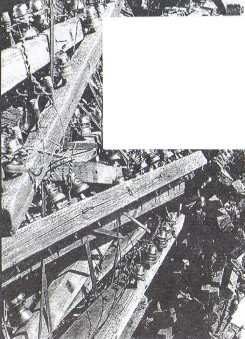 |
A few weeks later I doubted even further that mine was the rare one pictured
when I collected three more (one smashed) of the same insulator from a place I
labeled the "insulator graveyard' (a massive piles of crossarms dumped in
the middle of a field). |
I thought, "Surely 4 of the same type indicates a fairly common
insulator, but... if these are the $100.00 ones, I could get a cobalt blue
Hemingray 19!" I called Bill Heitkotter to see if he could help me identify
this peculiar olive-ish green trio of CD145's. Since color cannot be seen through the phone wires, Bill recommended I take the three insulators
with me to a show and try to find some identical ones that someone was selling.
The next nearest show was hosted by Alan Stastny in West Manchester, OH. I took
quite a few insulators with me to the show. There I browsed to try to find one
identical to my olive-ish green CD 145's. I could not find any of the same color.
A person I recognized from the cover of a back issue of "Crown Jewels of
the Wire" introduced himself as Bob Stahr and we started talking. He told
me he would be glad to help me identify the insulators I had brought.
After I
handed him the CD 145, I knew something was up. He just stared at it. I broke
the silence by asking him what the possible value was. His head was still aimed
down toward the insulator nestled in his hands, but he raised his eyebrows and
said one word, "expensive."
"How expensive?"
"$1000.00" "I felt my stomach hit my knees! Really!?"
"That's a hard color."
The look on his face as he heard my next
statement was one of great surprise.
"I have two more just like it."
"Let's get these over here where more people can see them. Bring the rest
of your stuff too."
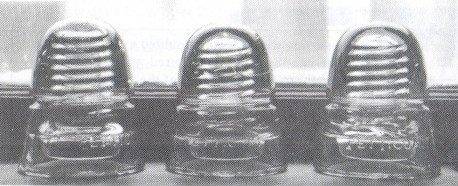
Three CD 145 H.G.CO., PETTICOAT beehives
As we went to where the others were standing, people started to crowd around.
Of the people I remember, (I was in a daze), Pete Bishop, Rick Soller, Steve
Blair, and Chuck Dittmar were there.
After the excitement died down, general
consensus had it that the color was more-olive yellow-olive-green for one of
them and the other two were the more-yellow yellow-olive-green. I personally
could not see a difference in the colors. The "more-olive..." was said to be
approximately $800.00. The other two were $300.00. It seemed everybody wanted
them. I was excited because I felt that no matter what insulator I saw at the
show, I could afford.
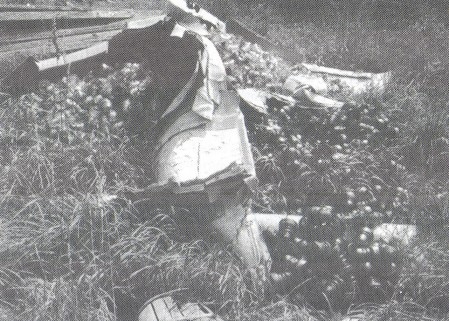
A pile of CD 162 Hemingray 19's in Hemingray blue,
aqua CD 152 Hemingray
40's, Hemingray CD 214's,
H. G. CO. signals and CD 145 H. G. CO. beehives.
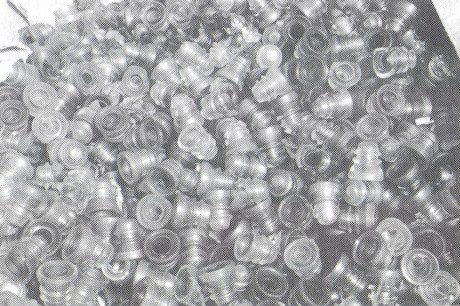
A huge pile of clear Hemingray-42 's.
I went against my natural impulse to sell the expensive
ones (I was told to contact Dwayne Anthony and Ray Klingensmith because
consignment was the better way to go) and sold some other CD145's I had with me.
To my surprise got $100.00, and so I purchased another insulator I had always
wanted - Alan Stastny sold me an orange amber CD162 Hemi 19. Finally! Another 25
year old dream come true!
I knew now that I had to attend the coming NIA
National Show in Williamsburg. Since I now owned three of my 'dream insulators,'
my hopes were that I would sell the more expensive of the CD 145 trio so I could
purchase both a cobalt CD 162 and a royal purple CD 145. I consulted via e-mail
with other collectors (considered experts by us novices!) such as Bill Meier
and Dwayne Anthony, about possible values on the three. They both told me to
look them up at the National so they could see them, and for the first time I
heard an insulator called pea-soup green.
The Ultimate Dream Come True
Upon arriving at the National, I started to find the 'experts' I had heard
about and those I had corresponded with through e-mail. I found Bill and Jill
Meier, and after introductions, I handed Bill my CD 145 and asked him what he
thought. First he said nothing but just stared at the insulator (it reminded me
of Bob's first reaction). He then said, "There are three things that make
an insulator valuable, color, style, and availability. You have the right color
- pea soup green - this is a hard color," (is 'hard color' a standard term
that insulator collectors are instructed to say when seeing a rare piece?),
"You have the right style - a CD 145 HGCo Petticoat is very collectable.
And availability... you've got that too - this one is rare." He told me
they were indeed the rare pea-soup green he had e-mailed me about.
He then made
an offer to buy one of them for an amount far beyond what I ever thought I would
see for an insulator. It was my turn to be speechless. While waiting for a
reply, Bill reassured me he did not want to pressure me, but that I could think
about it. I decided to wait until I had time to hear other professional's
opinions, and to collect my thoughts (which I knew could only be possible after my feet once I again
descended from the six inches they had stolen from gravity's pull).
As I then
introduced myself to Ray and he said, "Oh, you must be the one that brought
the unusual colored beehives to the show in West Manchester." I was
surprised at what an impact these pieces of glass had made! He too talked about
the "hard color" that pea-soup green is. His evaluation was similar to
the one that Bill and Jill Meier gave me.
I then took the pieces to Dwayne
Anthony. When he asked me to step outside the show hall for a conference, I
thought, "I guess I'm not dreaming, this really must be something
big!"
The McDougalds were next, and Carol quietly informed me the
insulators were an interesting shade of "baby-poo" green! She shared
her background credentials of being able to accurately identify this color by
matter-of-factly stating, "I know, I have changed diapers!" She then
asked me where and when I had gotten them. I told her about my visit to the
'insulator junkyard' last April. She said how happy she was for me, and said
this serves as a good example to everyone that there are still good pieces out
there waiting to be collected.
I then decided to sell one of them to Bill and
Jill, but had to make a stop before I could. I appreciate what next happened.
At
the West Manchester show I had told Bob Stahr he could have first shot at one of
the '$300.00 ones'. I now went to Bob and started to discuss the pieces with him
again. I told him I wanted to honor his 'first shot', but told him that these
pieces had turned out to be far more valuable, and I quoted to him the offer by
Bill and Jill. His response was, "Remember, the first time I saw them I
told you they were worth $1000,00?" He had been right! I then relayed to
him that general consensus at this show was that all three were of equal value.
I said I did not want to dishonor what I had told him and he unselfishly said,
"Don't worry, I'd take the larger offer if I was you." I thanked him
and then found Bill and Jill. I sold them one. The others are to appear in Ray
Klingensmith's (I learned he only lives a few hours from me, how did I miss
meeting him, and other collectors, all these years?) consignment catalog.
For
the rest of the day I experienced something that I feel not many people have been
able to experience. Walking from table to table, the price tags melted away into
obscurity. It did not matter anymore what the cost was. The ultimate insulator
experience of being in a room surrounded by thousands of different insulators,
and any being able to own any of the ones I wanted was reality!
A New Perspective
Now in my dream world, it took a little for me to realize what was going on.
After a while of being dazed, a thought struck me that seemed to cut through my
euphoria like a knife. Originally, I started collecting insulators for the sheer
fun of it. Fun was the impetus that drove me onward. I now was faced with the
reality that somewhere my motivation had changed from fun to hopefulness of
stumbling onto a valuable find (which I 'knew' would never happen). I turned to
my friend Dave Heise and said, "Dave, what do I do now? I can afford any of
the insulators I've always wanted ... my goals are gone! I've heard the
saying, 'having is not so pleasurable a thing as wanting,' I understand it now!
"
I am thankful for his simple but wise reply: "Just collect what you
like - whatever appeals to you." The 'fun' of the hobby was/is back!
The Icing On The Dream
Three other parts of my 'ultimate insulator experience' have to be mentioned.
They are 'icing on the cake." The first is that my Dad has started to ask
me to go insulator hunting! The second is that other family members have started
to pick up insulators and give me leads as to where they have heard of available
ones. And the third, and most memorable part, is the reaction I got upon sharing
the happenings of NIA National with my in-laws.
My family had been staying at my
in-laws house while I attended the show. When my in-laws first heard I was traveling
500 miles from home to go see a show where people "collected
pieces of glass from telephone poles" they were wondering a little about my
sanity. When I returned to their home that night after the show, I started
slowly and deliberately, piece by piece, to lay my new insulators on the table.
I went from the least to most expensive and gave them time to examine each
insulator as I presented them. The look on their faces at the $15.00 royal
purple CD 102 B. T. CO was one of "Well... O.K. ... it is pretty." The
$40.00 royal purple CD145 G.N.W. TEL. CO. brought a look of "Pretty... but
that's a little much for a chunk of glass." The $75.00 CD162 W.F.G. Co was
one of "He's gone off the deep end." When I pulled out the $375.00
cobalt blue CD162 Hemingray 19, I hurriedly told them I got a bargain since I
only paid $350.00. I waited for a second. Nothing was said.
I then told them I
could afford these because of my sale. Bit by bit I laid the bills on the table
as their eyes widened. I let it all settle in for a few seconds and then told
them this was what I got for just for ONE insulator. I told them I had two more identical ones that were to be
sold. After I relayed the details of the day's activities, they wanted to see
the video footage I took at the show!
As a Christian, and a teacher in a
Christian school, I am one who believes that everything in our lives happens
according to God's design. I have had what I believe to be the ultimate
experience I could ever dream of as an insulator collector. I thank God for this
opportunity. He blessed me that day with more enjoyment than I have experienced
in a long time!
I hope this account is an inspiration to all to keep looking
and not to give up hope - dreams can come true! I also have learned that this
hobby is full of truly wonderful people. Never once did I hear anything bad said
about others when finding who to work with on these rare jewels. The courtesy
and friendship of the people involved with this hobby are definitely an uncommon
thing in today's society. I feel that not only do I have a new perspective on
the hobby, but I feel like I have joined a new circle of people who will come to
be great friends. The people in our hobby are unique for it seems they really do
care about the each other. I appreciate all of the correspondence and
friendships I have made through these 'chunks of glass.' I give my thanks to all
those I mentioned here (and others I met at the shows). If you novices (like me)
have not met these 'experts', get to a show and do so! It is these people, and
others like them, who make this hobby great! And, please, feel free to e-mail me
at LBrewer42@tbscc.com, I enjoy corresponding with fellow collectors!
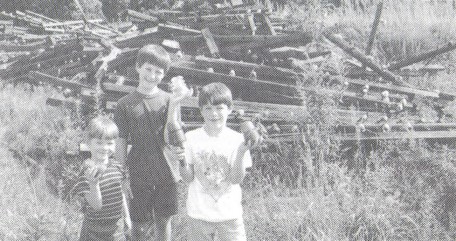
Pictured in the ''field of crossarms" are the Brewer boys:
(left to
right) Stephen (NIA # 6699), Samuel (NIA #6697)
and Seth (NIA #6698)
| 